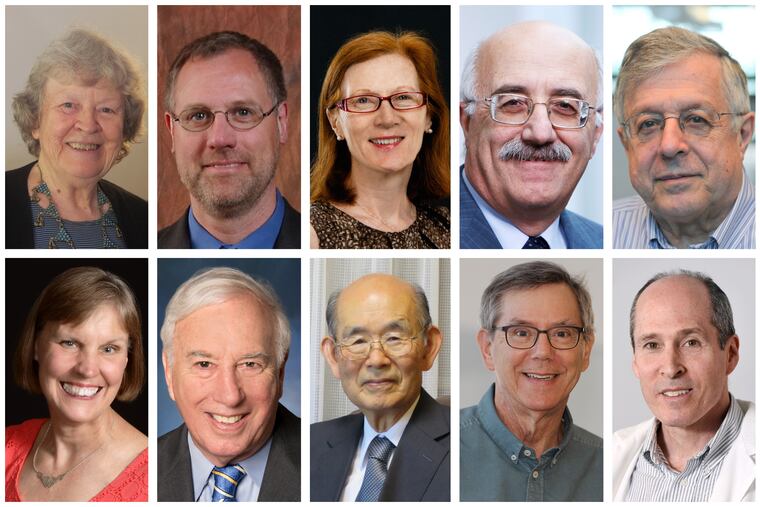Franklin Institute honors pioneers in the study of forest fires, longevity, eyesight
Pioneers in such fields as climate change, mechanical engineering, genetics, chemistry, and computer science will be honored at a black-tie ceremony April 30 in Philadelphia.

When Yellowstone National Park was ravaged by fire in 1988, Monica Turner saw its forests start to recover within a year. The intense heat had caused lodgepole pine cones to open and release their seeds, a natural process that had been occurring every century or two for the last 10,000 years.
What has happened since then, she fears, is unnatural.
In 2016, much of the same area burned again — before many of the new trees had grown cones to keep the cycle going.
Turner’s work, projecting what will happen to forests in a hotter, drier climate, has earned her one of the Franklin Institute’s annual science awards, the museum announced Monday. The others are pioneers in such fields as mechanical engineering, genetics, chemistry, and computer science, and will be honored at a black-tie ceremony April 30. Nine scientists in all are sharing seven awards, and a 10th honoree, biotech-industry titan and Apple Inc. chairman Arthur D. Levinson, is getting an award for business leadership.
Honorees also will participate in lectures and other events, including an April 28 “Laureates Lab,” during which they field questions from any museum-goers who happen by.
“This is where you really see how terrific these folks are,” said Donald E. Morel Jr., chair of the institute’s board. “They’re teachers.”
Here are the winners:
Kunihiko Fukushima, Bower Award in Science
Fukushima has been making waves in artificial intelligence and machine learning since the 1960s, developing theoretical models of how the brain acquires and processes information.
He is best known for one he devised in 1979, the neocognitron — a “deep” neural network that describes how a computer can learn to recognize visual patterns. A longtime university professor in Japan, he now is a senior research scientist at Fuzzy Logic Systems Institute in Fukuoka.
Arthur D. Levinson, Bower Award for Business Leadership
As CEO, Levinson steered Genentech through the testing and 1998 approval of the breast-cancer drug Herceptin, the first medicine genetically “targeted" to attack a tumor..
Before moving to the executive suite, Levinson was a Ph.D. scientist at Genentech in the 1980s.
In addition to holding the chairmanship at Apple, a post he assumed in 2011, Levinson is chief executive officer of Calico LLC, a Bay Area biotech firm conducting advanced research on the biology of aging. Calico, founded in 2013, is funded by Alphabet Inc., the parent company of Google.
Roberto Car and Michele Parrinello, chemistry
Car, a theoretical physicist at Princeton, and Parrinello, a computational chemist at the Swiss university ETH Zurich, jointly developed a technique in the 1980s for predicting the movement of atoms and electrons.
Called the Car-Parrinello method, it has been described as a “virtual microscope.”
Barbara H. Partee, computer and cognitive science
Partee, a Swarthmore College graduate and professor emerita at the University of Massachusetts at Amherst, is considered the founder of a sub-field of linguistics called formal semantics, teasing apart the logic and structure that underlies human communication.
Among her many contributions is the “Partee puzzle" — the fact that the two statements “The temperature is rising” and “The temperature is ninety” do not together mean “Ninety is rising.”
Monica G. Turner, earth and environmental science
A professor of ecology at the University of Wisconsin-Madison, Turner cautions against attributing any one event to human-induced climate change.
But forest fires are projected to become more common in a hotter, drier world. The fires in Australia are consistent with this pattern, as were the longer-than-usual fire seasons in California in 2017 and 2018, she said.
Still unclear is how forests will respond. In Yellowstone, the conventional wisdom was that young trees would not burn. Yet in 2016, they did, along with much of the deadwood on the forest floor.
Jeremy Nathans, life science
Nathans is famed for identifying the genes that enable humans to perceive color, work that began in the late 1970s when he was at Stanford University.
“I just happened to be in the right place at the right time,” said Nathans, a longtime professor at Johns Hopkins University.
In order to search retina cells for DNA sequences that might be involved in recognizing color, he had to painstakingly assemble genetic “probes," one DNA base-pair at a time — a multiday process that today would take a robot a few hours.
C. Daniel Mote, mechanical engineering
Mote, a professor and former president of the University of Maryland in College Park, is an expert in behind-the-scenes technologies that drive much of modern life: spinning disks, tapes, cables, and other “axially moving materials." Among his innovations was improving the stability of rotating saw blades, resulting in reduced wood waste.
He also was a pioneer in measuring the forces that downhill skiers experience on their lower legs and knees, leading to the eventual development of safer bindings.
Henry C. Kapteyn and Margaret M. Murnane, physics
Kapteyn and Murnane, professors at the University of Colorado at Boulder, are research partners as well as husband and wife. They are known for developing ultra-fast, high-intensity X-ray lasers that enable scientists to capture the details of chemical reactions in minute detail.
Their work has applications in such diverse fields as biology and astronomy, leading Morel to remark on how distinctions among the sciences can be artificial.
“The laser technologies invented by the physicists get used by the chemists to study how reactions happen,” he said. “The boundaries between traditional disciplines have become so blurred.”